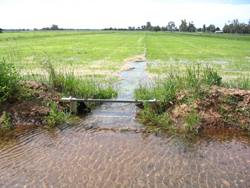4.1.4.1 - What flow rates should I use?
Return to Main Menu | Return to Step 4 | Return to Step 4.1 | Return to Step 4.1.4 | Next Step
| The irrigation system designer normally specifies flow rates onto the bays. Changing the flow rate specifications can result in less uniform water distribution over the bays, and either - increasing deep seepage and waterlogging (with lower flow rates and longer irrigation times), or - stressed pasture (with higher flow rates and shorter irrigation times). The DEPI Agnote Border-check Irrigation Design provides guidelines for the determination of optimum flow rates. Automation of the irrigation process minimises labour requirements. Financial assistance is available to install automatic irrigation on border-check irrigation systems in the SIR. For more information, contact your local DPI office. Spinner-cut drains are sometimes used to help get water onto the bay, or to facilitate drainage off the bay. They can be used where the supply head in the channel is limited, or where relatively flat bays do not drain well. |
 The flow rate onto the bay is important for efficient irrigation |
An irrigation system designer normally determines the feasible flow rates onto bays, based on the specifications of the farm irrigation system and characteristics of the farm water supply.
The following irrigation bay inflow rate guidelines are from the DEPI project Improving border-check irrigation performance:
- On soils with medium to heavy clay subsoils, (Soil Groups 3 to 6) or with a high watertable, increasing inflow rates above 0.1 Ml/day/m of bay width will have minimal impact on potential irrigation efficiency and water savings..
- On lighter soil types, (Group 2 soils without a strong texture contrast to a medium to heavy clay subsoil), the most appropriate inflow rate depends on the irrigation deficit. The project found that a flow rate of 0.4 Ml/d/m could efficiently irrigate a lucerne crop with a 67 mm deficit, but could not adequately irrigate the same crop with a 95 mm deficit without substantial runoff. At 95 mm deficit an inflow rate of 0.1 Ml/d/m was more efficient. A similar soil with a shallow rooted pasture created substantial deep drainage no matter what inflow rate was used.
- In general, increasing inflow rates beyond 0.2 ML/d/m bay width can reduce the time spent irrigating but will not substantially improve potential irrigation efficiencies.
The DEPI Agnote Border-check Irrigation Design provides guidelines for the determination of optimum flow rates.


